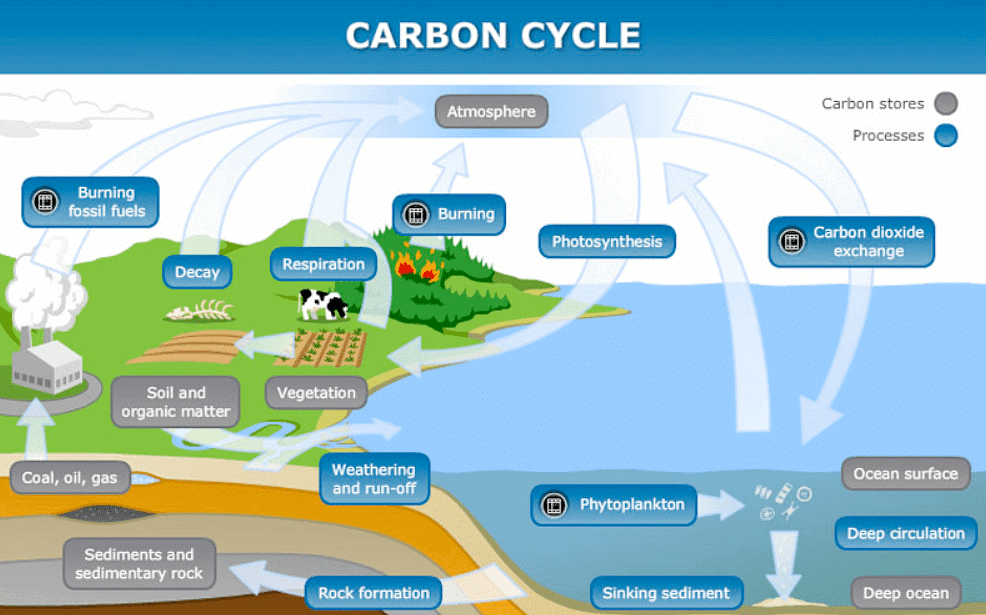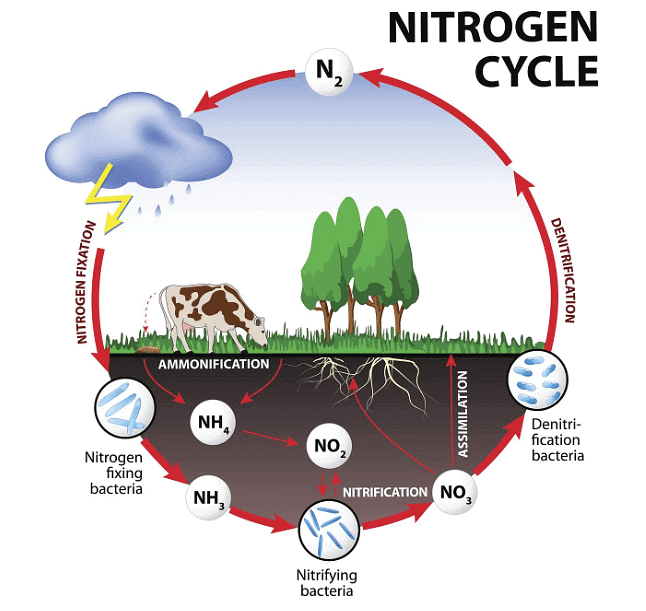Class 10 Exam > Class 10 Notes > Biology for GCSE/IGCSE > Nutrient Cycles
Nutrient Cycles | Biology for GCSE/IGCSE - Class 10 PDF Download
The Carbon Cycle
- Nutrients like carbon and nitrogen are finite resources, not endlessly available.
- Due to their limited availability, these elements must be recycled to support the growth of new organisms.
- Plants absorb carbon dioxide from the atmosphere during photosynthesis.
- Animals acquire carbon by consuming plants (and microorganisms).
- Carbon is released back into the atmosphere as carbon dioxide through respiration by plants, animals, and microorganisms.
- In environments lacking decomposing microorganisms, deceased organisms can undergo transformation into fossil fuels over millions of years under significant pressure.
- Combustion of fossil fuels leads to the release of carbon dioxide into the atmosphere.
- Increased usage of fossil fuels contributes to rising levels of atmospheric carbon dioxide.
- Widespread deforestation diminishes the number of plants available to absorb carbon dioxide through photosynthesis.
- Deforestation, particularly for land conversion purposes rather than timber extraction, further exacerbates the problem by releasing additional carbon dioxide into the atmosphere through burning.

Question for Nutrient CyclesTry yourself: What process releases carbon dioxide back into the atmosphere?View Solution
The Nitrogen Cycle
The nitrogen cycle encompasses the following stages:
- Nitrogen Fixation: Nitrogen fixation involves converting atmospheric nitrogen into forms usable by plants, carried out by nitrogen-fixing bacteria like Rhizobium.
- Nitrification: Nitrification is the process where ammonia is converted into nitrites and then nitrates by nitrifying bacteria such as Nitrosomonas and Nitrobacter.
- Assimilation: During assimilation, plants and animals absorb nitrates and ammonia to synthesize proteins and nucleic acids.
- Ammonification: Ammonification involves the decomposition of organic nitrogen compounds into ammonia by decomposers like bacteria and fungi.
These stages collectively highlight the intricate processes involved in the nitrogen cycle:
- Nitrogen and Protein Synthesis
- Nitrogen is a crucial element necessary for the formation of proteins.
- Challenges in Nitrogen Absorption
- Plants and animals face difficulty in absorbing nitrogen directly from the air due to the stability of N2 gas.
- The strong triple covalent bond between nitrogen atoms requires significant energy to break.
- Processes of Nitrogen Conversion
- Nitrogen-fixing bacteria, present in soil and root nodules of specific plants like peas and beans, convert N2 gas into nitrates, aiding absorption.
- Lightning plays a role in fixing N2 gas by breaking its bond, leading to the formation of nitrous oxides that dissolve in rainwater and enter the soil.
- Nitrogen Utilization by Plants and Animals
- Plants absorb nitrates from the soil, utilizing the nitrogen to synthesize proteins.
- Animals acquire the necessary nitrogen by consuming plants or other animals rich in proteins.
- Animal waste, such as urine and feces, returns nitrogen to the soil in the form of ammonium compounds.
- Nitrogen Recycling Process
- Upon death, plants and animals decay, releasing proteins as ammonium compounds back into the soil with the help of decomposers.
- Nitrifying bacteria convert ammonium compounds into nitrites and then nitrates, facilitating plant absorption in a continuous cycle.
- Impact of Denitrifying Bacteria
- Denitrifying bacteria, found in poorly aerated soil, reverse the process by converting nitrates back into N2 gas, reducing nitrogen availability.
- Farmers can mitigate the presence of denitrifying bacteria through soil management practices like ploughing.
The Nitrogen Cycle
- Plants take in nitrates from the soil and utilize nitrogen to produce proteins.
- Animals acquire the necessary nitrogen by consuming plants or other animals which contain proteins.
- Animal waste, such as urine and feces, returns nitrogen to the soil in the form of ammonium compounds.
- Upon the death and decomposition of plants and animals, proteins are broken down into ammonium compounds by decomposers.
- Plants are unable to directly absorb ammonium compounds. Nitrifying bacteria convert these compounds into nitrites and then nitrates, which can be taken up by plants.
- Denitrifying bacteria found in poorly aerated soil extract nitrates from the soil and convert them back into N2 gas.
- Farmers can mitigate the presence of unhelpful denitrifying bacteria by ploughing and aerating the soil.
Additional Information
- The nitrogen cycle is crucial for the continuous recycling of nitrogen in ecosystems.
- Nitrogen gas makes up about 78% of Earth's atmosphere, but most organisms cannot use it directly.
- Nitrogen-fixing bacteria in the soil and root nodules of certain plants play a vital role in converting atmospheric nitrogen into forms usable by plants.
- Nitrogen is an essential component of amino acids, the building blocks of proteins, which are essential for the growth and development of all living organisms.
Significance of the Nitrogen Cycle
- The nitrogen cycle ensures that nitrogen is continuously available for the growth of plants, which form the base of the food chain.
- It helps maintain the balance of nitrogen in various ecosystems, preventing nutrient imbalances that could harm plant and animal life.

The document Nutrient Cycles | Biology for GCSE/IGCSE - Class 10 is a part of the Class 10 Course Biology for GCSE/IGCSE.
All you need of Class 10 at this link: Class 10
|
110 videos|210 docs|33 tests
|
FAQs on Nutrient Cycles - Biology for GCSE/IGCSE - Class 10
| 1. What are the main processes involved in the carbon cycle? |  |
Ans. The main processes involved in the carbon cycle include photosynthesis, respiration, decomposition, and combustion.
| 2. How does deforestation impact the carbon cycle? |  |
Ans. Deforestation reduces the number of trees available to absorb carbon dioxide through photosynthesis, leading to an increase in atmospheric carbon levels and contributing to climate change.
| 3. What role do oceans play in the carbon cycle? |  |
Ans. Oceans act as a carbon sink, absorbing carbon dioxide from the atmosphere through a process known as oceanic carbon sequestration.
| 4. How does human activity affect the carbon cycle? |  |
Ans. Human activities such as burning fossil fuels and deforestation release excess carbon dioxide into the atmosphere, disrupting the natural balance of the carbon cycle.
| 5. What are some ways to mitigate the effects of carbon cycle disruption? |  |
Ans. Some ways to mitigate the effects of carbon cycle disruption include planting trees, reducing fossil fuel consumption, promoting renewable energy sources, and implementing carbon capture and storage technologies.
Related Searches















